
German postcard by Krüger, no. 902/247. Publicity still for Gypsy (Mervyn LeRoy, 1962).

German postcard by Krüger, no. 902/258.

German postcard by Krüger, no. 902/31.

German postcard by ISV, Sort. V/6.

Big German card by ISV, HX 98.
A little girl who drops ice cream cone
Natalie Wood was born Natalia Nikolaevna Zakharenko in San Francisco, USA, in 1938. Her parents were Russian immigrants. Her father Nikolai Stepanovich Zakharenko was a day laborer and carpenter and her mother Maria Zudilova was a housewife. Wood's parents had to migrate due to the Russian Civil War (1917-1923).
Maria had unfulfilled ambitions of becoming an actress or ballet dancer. She wanted her daughters to pursue an acting career, and live out her dream. Maria frequently took a young Wood with her to the cinema, where Maria could study the films of Hollywood child stars. The impoverished family could not afford any other acting training to Wood.
The Zakharenko family eventually moved to Santa Rosa, where young Wood was noticed by members of a crew during a film shoot. The family moved to Los Angeles to help seek out roles for her. RKO Radio Pictures' executives William Goetz and David Lewis chose the stage name Natalie Wood for her. The first name was based on her childhood nickname Natalia, and the last name was in reference to director Sam Wood.
Natalia's younger sister Svetlana Gurdin (1946) would eventually follow an acting career as well, under the stage name Lana Wood. Natalie made her film debut in the drama Happy Land (Irving Pichel, 1943) starring Don Ameche, set in the home front of World War II. She was only 5-years-old, and her scene as the 'Little Girl Who Drops Ice Cream Cone' lasted 15 seconds.
Wood somehow attracted the interest of film director Irving Pichel who remained in contact with her family over the next few years. Wood had few job offers over the following two years, but Pichel helped her get a screen test for a more substantial role opposite Orson Welles as Wood's guardian and Claudette Colbert in the romance film Tomorrow Is Forever (Irving Pichel, 1946). Wood passed through an audition and won the role of Margaret Ludwig, a post-World War II German orphan.
At the time, Wood was "unable to cry on cue" for a key scene. So her mother tore a butterfly to pieces in front of her, giving her a reason to cry for the scene. Wood started appearing regularly in films following this role and soon received a contract with the film studio 20th Century Fox.
Her first major role was that of Susan Walker in the Christmas film Miracle on 34th Street (George Seaton, 1947), starring Edmund Gwenn and Maureen O'Hara. The film was a commercial and critical hit and Wood was counted among the top child stars in Hollywood. She received many more to play in films.
She typically appeared in family films, cast as the daughter or sister of such protagonists as Fred MacMurray, Margaret Sullavan, James Stewart, Joan Blondell, and Bette Davis. Wood appeared in over twenty films as a child actress. The California laws of the era required that until reaching adulthood, child actors had to spend at least three hours per day in the classroom, Wood received her primary education on the studio lots, receiving three hours of school lessons whenever she was working on a film. After school hours ended, Wood would hurry to the set to film her scenes.
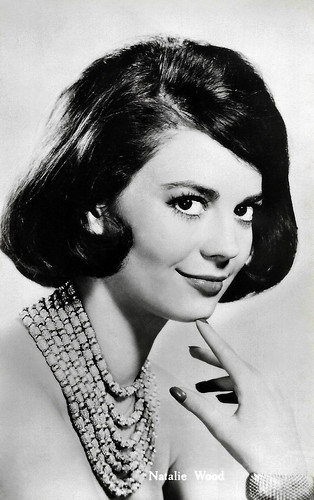
Dutch postcard by Int. Filmpers, Amsterdam, no. 363 / 817.

Italian postcard, no. 402.

Italian postcard by Rotalfoto, no. 748. Collection: Marlene Pilaete.

Italian postcard by Bromofoto, Milano, no. 1411. Photo: Warner Bros. Natalie Wood in Marjorie Morningstar (Irving Rapper, 1958).
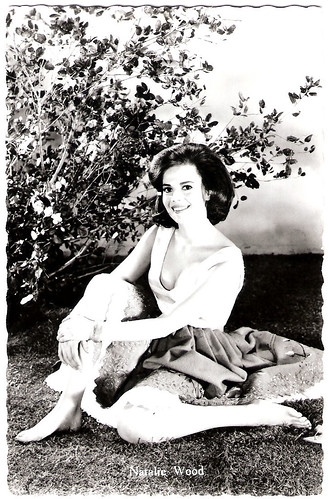
Dutch postcard. Sent by mail in the Netherlands in 1962. Publicity still for Splendor in the Grass (Elia Kazan, 1961). Collection: Geoffrey Donaldson Institute.
The transition from child star to ingenue
Natalie Wood gained her first major television role in the short-lived sitcom The Pride of the Family (1953-1954). At the age of 16, she found more success with the role of Judy in Rebel Without a Cause (Nicholas Ray, 1955) opposite James Dean and Sal Mineo. She played the role of a teenage girl who dresses up in racy clothes to attract the attention of a father (William Hopper) who typically ignores her. The film's success helped Wood make the transition from child star to ingenue. She was nominated for the Academy Award for Best Actress in a Supporting Role, but the award was instead won by Jo Van Fleet
Her next significant film was the Western The Searchers (John Ford, 1956), playing the role of abduction victim Debbie Edwards, niece of the protagonist Ethan Edwards (John Wayne). The film was a commercial and critical hit and has since been regarded as a masterpiece. Also in 1956, Wood graduated from Van Nuys High School, with her graduation serving as the end of her school years.
She signed a contract with Warner Brothers, where she was kept busy with several new films. To her disappointment, she was typically cast as the girlfriend of the protagonist and received roles of little depth. For a while, the studio had her paired up with teenage heartthrob Tab Hunter as a duo. The studio was hoping that the pairing would serve as a box-office draw, but this did not work out.
One of Wood's only serious roles from this period is the role of the eponymous protagonist in the melodrama Marjorie Morningstar (Irving Rapper, 1958) with Gene Kelly, playing a young Jewish girl whose efforts to create her own identity and career path clash with the expectations of her family. Wikipedia: "The central conflict in the film revolves around the traditional models of social behavior and religious behavior expected by New York Jewish families in the 1950s, and Marjorie's desire to follow an unconventional path." The film was a critical success, and fit well with other films exploring the restlessness of youth in the 1950s.
Wood's first major box office flop was the biographical film All the Fine Young Cannibals (Michael Anderson, 1960), examining the rags to riches story of jazz musician Chet Baker (played by Robert Wagner) without actually using his name. The film's box office earnings barely covered the production costs, and film studio Metro-Goldwyn-Mayer recorded a loss of 1,108,000 dollars. For the first time. Wood's appeal to the audience was in doubt.
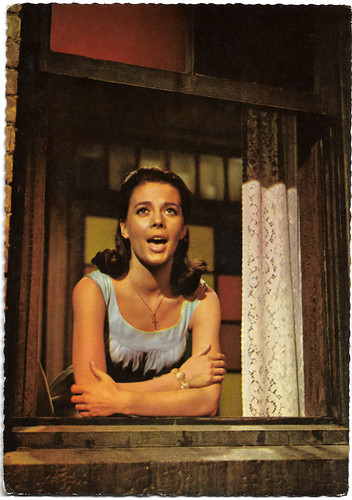
Dutch postcard by Gebr. Spanjersberg N.V., Rotterdam. Publicity still for West Side Story (Robert Wise, 1961).

Dutch postcard by Gebr. Spanjersberg N.V., Rotterdam. Richard Beymer and Natalie Wood in West Side Story (Robert Wise, 1961).

Dutch postcard by Gebr. Spanjersberg N.V., Rotterdam. Publicity still for West Side Story (Robert Wise, 1961).

Dutch postcard by Gebr. Spanjersberg N.V., Rotterdam. Richard Beymer and Natalie Wood in West Side Story (Robert Wise, 1961).

Dutch postcard by Gebr. Spanjersberg N.V., Rotterdam. Richard Beymer and Natalie Wood in West Side Story (Robert Wise, 1961).
A restless Puerto Rican girl named Maria
With her career in decline following this failure, Natalie Wood was seen as "washed up" by many in the film community. But director Elia Kazan gave her the chance to audition for the role of the sexually repressed Wilma Dean Loomis in Splendor in the Grass (Elia Kazan, 1961) with Warren Beatty. The film was a critical success and Wood was for the first time nominated for the Academy Award for Best Actress in a Leading Role. The award was instead won by rival actress Sophia Loren.
Wood's next important film was West Side Story (Jerome Robbins, Robert Wise, 1961), where she played Maria, a restless Puerto Rican girl. Wood was once again called to represent the restlessness of youth in a film, this time in a story involving youth gangs and juvenile delinquents. The film was a great commercial success with about 44 million dollars in gross, the highest-grossing film of 1961. It was also critically acclaimed and is still regarded among the best films of Wood's career. However, Wood was disappointed that her singing voice was not used in the film. She was dubbed by Marni Nixon, who also dubbed Audrey Hepburn in My Fair Lady (George Cukor, 1964), and Deborah Kerr in The King and I (Walter Lang, 1956).
Wood's next leading role was as the burlesque entertainer and stripper Gypsy Rose Lee in the Biopic Gypsy (Mervyn LeRoy, 1962) alongside Rosalind Russell. Some film historians credit the part as an even better role for Wood than that of Maria, with witty dialogue, a greater emotional range, and complex characterisation. The film was the highest-grossing film of 1962 and well-received critically.
Wood's next significant role was that of Macy's salesclerk Angie Rossini in the comedy-drama Love with the Proper Stranger (Robert Mulligan, 1963). In the film, Angie has a one-night stand with musician Rocky Papasano (Steve McQueen), finds herself pregnant, and desperately seeks an abortion. The film underperformed at the box office but was critically well-received. The 25-year-old Wood received her second nomination for the Oscar for Best Actress in a Leading Role, but it was won by Patricia Neal.
Wood continued her successful film career and made two comedies with Tony Curtis: Sex and the Single Girl (Richard Quine, 1964) and The Great Race (Blake Edwards, 1965), the latter also with Jack Lemmon and Peter Falk. For Inside Daisy Clover (Sydney Pollack, 1965) and This Property Is Condemned (Sydney Pollack, 1966), both of which co-starred Robert Redford, Wood received Golden Globe nominations for Best Actress.
However, her health status was not as successful. She was suffering emotionally and had sought professional therapy. She paid Warner Bros. 175,000 dollars to cancel her contract and was able to retire for a while. She also fired her entire support team: agents, managers, publicist, accountant, and attorneys. She took a three-year hiatus from acting.

British postcard in the Greetings series. Photo: Warner Bros. Collection: Marlene Pilaete.

German postcard by Rüdel-Verlag, Hamburg, no. 4547. Photo: Warner Bros. Natalie Wood in Inside Daisy Clover (Robert Mulligan, 1965).

Dutch postcard, no. 812.

Dutch postcard.
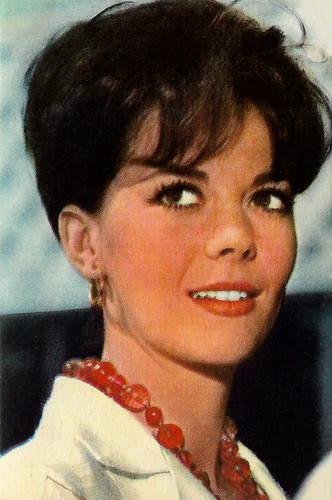
Small Belgian collectors card, no. 148.
Drowning and other undetermined factors
Natalie Wood made her comeback in the comedy-drama Bob & Carol & Ted & Alice (Paul Mazursky, 1969), with the themes of sexual liberation and wife swapping. It was a box office hit. Wood decided to gamble her 750,000 dollars fee on a percentage of the gross, earning a million dollars over the course of three years.
Wood was pregnant with her first child, Natasha Gregson (1970). She chose to go into semi-retirement to raise the child, appearing in only four more theatrical films before her death. These films were the mystery-comedy Peeper (Peter Hyams, 1975) starring Michael Caine, the Science-Fiction film Meteor (Ronald Neame, 1979) with Sean Connery, the sex comedy The Last Married Couple in America (Gilbert Cates, 1980) with George Segal and Valerie Harper, and the posthumously-released Science-Fiction film Brainstorm (Douglas Trumbull, 1983).
In the late 1970s, Wood found success in television roles. Laurence Olivier asked her to co-star with him in Cat on a Hot Tin Roof (Robert Moore, 1976). After that, she appeared in several television films and the mini-series From Here to Eternity (Buzz Kulik, 1979), with William Devane and Kim Basinger. For From Here to Eternity, she received a Golden Globe Award and high ratings.
She had plans to make her theatrical debut in a 1982 production of 'Anastasia'. On 28 November 1981, during a holiday break from the production of Brainstorm (1983), Natalie Wood joined her husband Robert Wagner, their friend Christopher Walken, and captain Dennis Davern on a weekend boat trip to Catalina Island. The four of them were on board Wagner's yacht Splendour.
On the morning of 29 November 1981, Wood's corpse was recovered 1 mile (1.6 kilometers) away from the boat. The autopsy revealed that she had drowned. Wikipedia: "The events surrounding her death have been the subject of conflicting witness statements, prompting the Los Angeles County Sheriff's Department, under the instruction of the coroner's office, to list her cause of death as 'drowning and other undetermined factors' in 2012. In 2018, Wagner was named as a person of interest in the ongoing investigation into Wood's death."
Natalie Wood was buried in Westwood Village Memorial Park Cemetery in Los Angeles. Her would-be comeback film Brainstorm (Douglas Trumbull, 1983) was incomplete at the time of her death. It was ultimately finished and released, but Wood's character had to be written out of three scenes while a stand-in and changing camera angles were used for crucial shots.
Natalie Wood was married three times. Her second husband was the British film producer and screenwriter Richard Gregson (1969-1972). She was twice married to actor Robert Wagner, from 1957 till 1962 and from 1972 till her death in 1981. She had two daughters, Natasha Gregson Wagner (1970) with Richard Gregson, and Courtney Wagner (1974) with Robert Wagner. The 2004 TV film The Mystery of Natalie Wood chronicles Wood's life and career. It was partly based on the biographies 'Natasha: the Biography of Natalie Wood' by Suzanne Finstad and 'Natalie & R.J.' by Warren G. Harris. Justine Waddell portrayed Wood.
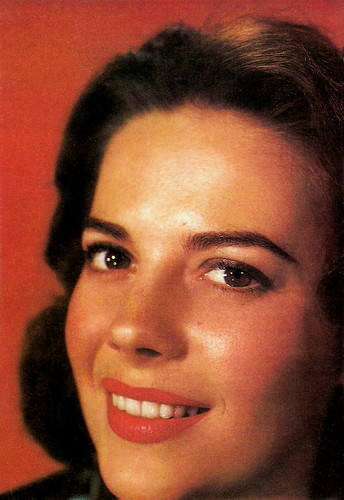
Spanish postcard by Postal Oscarcolor, Hospitalet (Barcelona), no. 31.

Spanish postcard by Raker, no. 1098, 1964.

Spanish postcard by Archivo Bermejo, no. 146 C, 1964. Photo: United Artists. Richard Beymer and Natalie Wood in West Side Story (Robert Wise, Jerome Robbins, 1961).

Spanish postcard by Archivo Bermejo no. C-72, 1963. Photo: Warner Bros. Publicity still for Gypsy (Mervyn LeRoy, 1962).

Spanish postcard by Oscar Color S.A., Hospitalet (Barcelona), no. 634d. Collection: Marlene Pilaete.

Spanish postcard, no. 342.

Italian postcard by Rotalfoto, Milano, no. N. 41.

Romanian postcard by Casa Filmului Acin.
Sources: Dimos I (IMDb), Wikipedia, and IMDb.
This post was last updated on 9 August 2021.
No comments:
Post a Comment